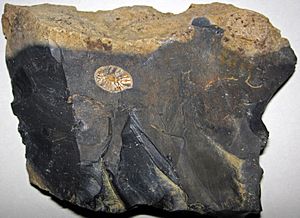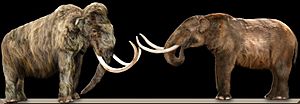Welling Site facts for kids
Quick facts for kids Welling Site |
|
|---|---|
| Lua error in Module:Location_map at line 420: attempt to index field 'wikibase' (a nil value). | |
| Location | Nellie, Coshocton County, Ohio |
The Welling Site is a really old place where early humans, called Paleo-Indians, lived a long, long time ago. It's an archaeological site in Ohio where people found many clues about these ancient groups. This spot was important because it had a special kind of stone called Upper Mercer flint. People came here to dig up this stone and make tools.
Scientists studied the tiny marks on the stone tools found here. They think the Welling Site was like a main camp. Here, different groups of Paleo-Indians might have met up. They could have learned how to make Clovis tools, shared food, traded information, and even found partners from other groups.
Contents
What is the Welling Site?
The Welling Site is located in Coshocton County, Ohio, near the town of Nellie. It sits in the Walhonding River Valley. This area is special because it was not covered by glaciers, unlike many other parts of Ohio.

The hills around the valley are made of bedrock that contains Upper Mercer flint. This flint was very important to ancient people. They dug it out of the ground to create strong stone tools. The site itself is about 15 feet above the Walhonding River floodplain. Some parts of the site might have changed when a railroad line was built nearby.
Discovering the Ancient Site
The Welling Site was first found by a person named Carrell Welling. He discovered two flint tools near his home in 1963 or 1964. This exciting find led to more exploration.
In August 1965, a team from the Case Institute of Technology came to dig at the site. They found many amazing things, including:
- 54 fluted points from the Paleo-Indian period. Some were finished tools, and others were still being made.
- Six Kirk complex and ten Brewerton complex projectile points. These were from a later time called the Archaic period.
- Lots of flint pieces and tools at different stages of completion. This showed that the site was a "workshop" where tools were made.
Most of the tools were made from the flint found right at the Welling Site. However, four fluted points were made from a different type of stone called Vanport flint. Even tools from the later Woodland period were mostly made from Upper Mercer flint.
Learning from the Past
In 1970, an amateur archaeologist named Norman L. Wright worked on a nearby site. He teamed up with Olaf Prufer from Kent State University. They compared the tools from the Welling Site to those from other ancient sites. They also wrote an article about the Welling Site for a magazine.
Their research showed that the Welling Site is a very early Paleo-Indian site. The oldest tools found there are fluted points from around 12,000 B.C. These tools are considered "classic Paleo-Indian." They were made at a time when huge animals like mastodons roamed the land. Thousands of tools were made at this site over many centuries.
Why Was Welling Site Important?
When Paleo-Indians needed stone for tools, places like the Welling Site were perfect. These stone outcrops were natural meeting spots for different groups. It was a great chance to:
- Learn new ways to make complex Clovis fluted projectile points.
- Practice making tools with plenty of stone available.
- Meet other groups, share information, and even find partners.
- Eat and interact in large gatherings.
Scientists used a special method called microwear analysis on the stone tools. This helped them understand how the tools were used. They found that tools from the Welling Site were used for many tasks, such as:
- Processing meat and hides after a hunt.
- Butchering meat and sawing bones.
- Scraping fresh and dry animal hides.
- Cutting hides.
- Sawing and scraping wood.
- Scraping bone or antlers.
- Scraping plants.
This shows that the Welling Site was a busy and important place for early humans.
Further Reading
- G. Logan Miller, Michelle R. Bebber, Ashley Rutkoski, Richard Haythorn, Matthew T. Boulanger, Briggs Buchanan, Jennifer Bush, C. Owen Lovejoy & Metin I. Eren (2019) "Hunter-gatherer gatherings: stone-tool microwear from the Welling Site (33-Co-2), Ohio, U.S.A. supports Clovis use of outcrop-related base camps during the Pleistocene Peopling of the Americas," World Archaeology, 51:1, 47-75, DOI: 10.1080/00438243.2018.1461128


